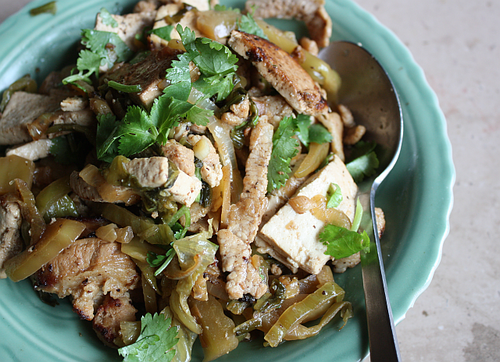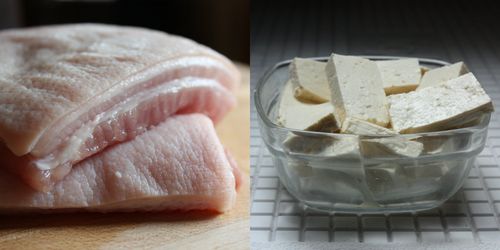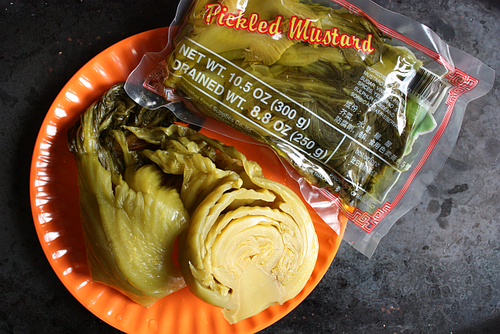
Something magical happens when you combine thinly sliced
pieces of pork belly with an assertive pickled vegetable and tofu. I didn’t
realize that kind of synergy till I made Korean tofu stir-fried with kimchi and
pork belly (dubu kimchi). It’s a drinking classic, I was told by my friend
Linda Lim, a Korea- born woman whose
petite size belies her enormous ability to eat and drink.
I made dubu kimchi repeatedly to get the recipe down for the
tofu book, and in the process learned to understand how the three ingredients
worked. The pork belly lent its wonderful richness to soften the blow of the
harsh kimchi, which had to be the stinky, mature kind for the dish to shine.
The tofu played an intermediary role to soak up the meat’s richness and the
umami funk of the pickled cabbage.
That said, I couldn’t resist making this stir-fry from Naomi
Duguid’s sensational Burma: Rivers of
Flavor, released just this fall. With her former husband, she
wrote landmark works such as Beyond the
Great Wall, and Hot, Sour, Salty
Sweet. This is her solo performance and it’s compelling, well sized for cooking and reading. Unlike her previous large scale productions, Burma is a book meant for using in the kitchen or holding on the sofa, not displaying on the coffee table.
Naomi has been traveling to Burma for decades, observing,
tasting, and noting a great deal of detail about the country, which stands at a
true culinary crossroads of South Asia, East Asia and Southeast Asia. All this
means that if you’re adept at cooking foods from Asia and venturing to Asian
markets, you’ll find Burma to be a splendid book to cook from. If you’re not
adept at those cuisines, then Naomi gives you a pass and says it’s okay to just
be an armchair cook and eater. In any event, you’ll relish the heartfelt writing and immense research in Burma.
For this stir-fry, you have to go to a Chinese or Southeast
Asian market because you need pickled mustard greens. I have made it in the
past but it an easy-to-find import from Thailand. The 10.5-ounce (300-gram)
packages are often sold unrefrigerated. Compared to homemade mustard greens
(made from large slightly bittersweet gai choy), the packaged stuff is super
salty. I rinse and squeeze it firmly to reduce the saltiness.
While you’re at the Asian market, get fresh pork belly (thit ba chi in Vietnamese).
Naomi’s recipe in Burma called for 2
pounds (900 grams) of skin on belly, trimmed down to 1 ¾ pounds (840 grams) once the skin was
removed. I used half of that amount and was fine. My pork belly was labeled “lean”
and the result was good but not as luscious as I would have liked. The lesson:
Go for the fat. The pieces below were lacking unctuousness.

Additionally, if the Asian market has pre-sliced pork belly –
buy it and save yourself time; the skin is usually already removed. If the skin
remains, the slices are so thin that you may like its slight chewiness. Keep
it. For the tofu, extra-firm holds its shape well for the rough and tumble
journey in the wok. My husband and I ate this with rice for a traditional meal.
Naomi suggests it atop polenta too. I bet it would be nice as a taco
filling as well, maybe with a squirt of Sriracha.
Three Layer or Five Layer Pork Belly
In Burma, this recipe is called "Three-Layer Pork with Mustard Greens and Tofu." Naomi points out that in Burmese, Thai and Chinese, pork belly is called three layers for the layering of fat and lean. In Vietnamese, it's more or less the same idea of 3 layers in the term thit ba chi.
I've seen Chinese reference to pork belly as "five flower pork" to denote the striations. My sense is that it depends on how the lean the pork belly is. The fattier pork belly tends to look like there are just 3 layers of fat and lean where as the 5-layer one has more layers. If you count the layers on the lean pieces I have above, there are 4 layers, excluding the skin. Any thoughts on this?
For presenting in this post, I went for clarification and called it pork belly.
RECIPE
Burmese Pork Belly,
Pickled Mustard Greens and Tofu
Yields: 4
servings
Ingredients
- 1 pound / 450 g pork belly, in one piece, or 14 ounces / 390
g pre-sliced pork belly - ¼ cup peanut oil or vegetable oil
- 1 medium yellow onion, quartered and thinly sliced crosswise
- One (10.5 oz / 300 g) package pickled mustard greens, rinsed
well, cored and thinly sliced crosswise (2 cups total) - 12 oz / 360 g extra-firm tofu, thinly sliced into bite-sized
pieces - About ½ teaspoon salt
- About ½ cup water
- ½ cup coarsely chopped cilantro leaves
Instructions
- If using a whole piece of pork belly, cut it across the
grain into 2-inch (5 cm) wide strips. Use a boning knife to remove the skin
(like you would do to a salmon filet); save or discard the skin. Cut the pork
belly across the grain as thin as possible. (If you have pre-sliced pork belly
cut it into pieces about 2 inched (5 cm) wide.) Set aside. - Heat a wok over medium heat. Add the oil, then the onion.
Cook, stirring occasionally, until translucent and softened, about 5 minutes.
Bank the onion, raise the heat to medium-high, then add the pork. Cook, turning
and pressing for 3 to 5 minutes, until all the pork has changed color and
started to render its fat; a little browning is great. Add the mustard greens,
stir well to combine and cook for several minutes to heat through. - Add the tofu and salt. Gently stir or better yet, give the
wok some solid jerks to combine the ingredients to minimally break up the tofu. Put a few pieces of tofu on the wall of the wok to let them brown and take on some character. - Add the water, cover, and cook for 3 to 5 minutes.
Occasionally uncover and jerk the pan to toss the ingredients. The dish is done
when the mustard greens have softened and the flavors blended. Off heat, add
the cilantro. Let this dish sit for about 10 minutes to develop its flavor.
Serve hot, lukewarm, or at room temperature.
Recipe adapted from Naomi Duguid's Burma: Rivers of Flavor (Artisan, 2012)
Related recipes
- Giant
Fried Jiaozi Dumplings recipe from Beyond the Great Wall - Tofu, Kimchi, and Bacon Taco recipe
More recipes from 2012 Asian Cookbooks
- Homemade Bun Rice Noodles from Vietnamese Home Cooking by Charles Phan
- Faux Viet Crab Noodle Soup from Vietnamese Street Food by Tracey Lister and Andres Pohl
- Fried Ginger Chicken from Japanese Farm Food by Nancy Hachisu
- Soy-Glazed Black Pepper Chicken from The Hakka Cookbook by Linda Anusasananan


















Suzette says
I love the vermicelli rice noodles fried with duck and pickled greens (fatty meat + pickles = yummy), and this recipe reminds me of it. Will file this recipe under "To try soon!"
Andrea Nguyen says
Why not sub the duck for the pork belly in this recipe? Your noodle dish sounds ridiculously good.
Linda Anusasananan says
Isn't the fifth layer in 5 flower pork the skin? I was told that the texture of the skin is appreciated although it does take longer to cook with the skin.
Lori says
I made this recipe the other night and it turned out well! I liked it a lot but my family thought that the "3-layer" pork belly was actually too much. I will try this again with some thinly sliced pork shoulder. (I loved the p-belly but need to accommodate the whole family.) 🙂
I have Naomi Duguid's Beyond the Great Wall and I like it very much except for the shape of the book. It takes up too much space in my small kitchen. You might be interested in her recipe for pressed tofu with scallions and ginger. I make this regularly in the summer. I use several recipes from this book but have made copies of the pages to refer to while cooking. The book itself is unwieldy. :O)
Irene says
This dish is popular in Shan State, Myanmar- close to China. As more Chinese people make this dish rather than the Burmese. That region is cooler , very mountainous and abundance w mustard greens. During warmer months, people live in that region pickle the mustard greens by sun dried n bottled - some add chile -so that they can have it year round. Also w tofu soup with meat broth is very common due to its cold weather.
My mother is from that area and her family buys the mustard greens by the case and dries them on bamboo racks.
Andrea Nguyen says
Irene, thank you for the Burmese lowdown! I thought that this was more of a Chinese thing than a Burmese dish since the tofu is made of soybeans instead of legume.